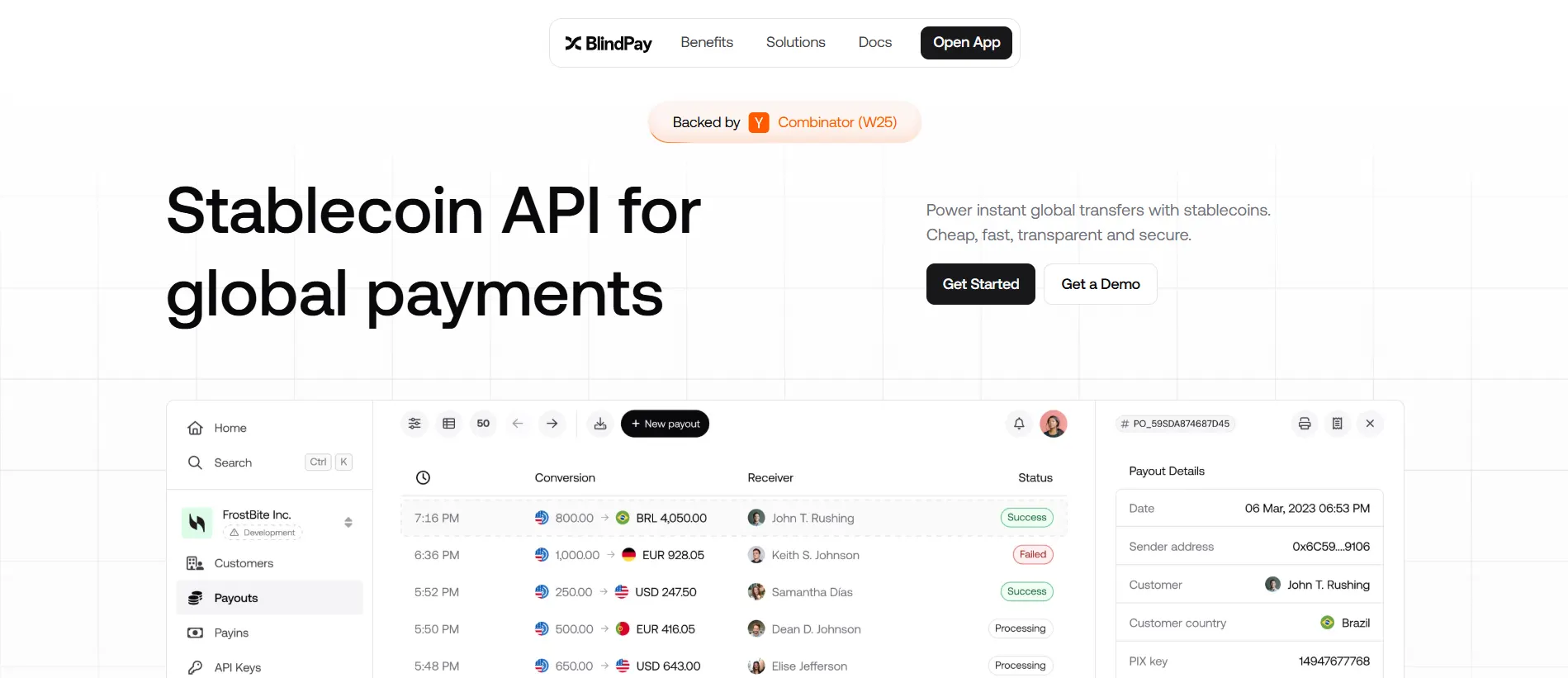BlindPay is a platform for international transfers that combines the capabilities of stablecoins and local fiat systems. It is designed for businesses that need fast, affordable, and reliable payments, especially in countries with high inflation and complex currency regulations. With the BlindPay API, companies can connect to local payment rails, operate 24/7, and meet all KYC/KYB requirements while avoiding the complexities of traditional bank transfers.
- Concept and Purpose of BlindPay
- Problems of Traditional Transfers and BlindPay's Approach
- Technical Architecture and Integrations
- Team and Investments
- Development Prospects and Conclusion

Concept and Purpose of BlindPay
BlindPay is an API solution that allows businesses to integrate international transfers into their products without having to build complex financial infrastructure themselves. The platform combines blockchain technology with local payment systems, such as Pix in Brazil or SPEI in Mexico, enabling instant conversion of stablecoins to fiat and back. BlindPay is registered as a Money Services Business with FinCEN, which allows it to operate within the legal framework and ensure transaction security. Thanks to a simple REST API and SDK for popular programming languages, integration takes minimal time and requires no deep blockchain expertise.
Problems of Traditional Transfers and BlindPay's Approach
Traditional bank transfers are often accompanied by long delays, high fees, and complex bureaucracy. In Latin American countries, additional barriers include inflation and unstable national currencies, meaning the transfer value can change during processing. BlindPay eliminates these issues by offering instant transactions, automatic conversion, and transparent tracking of operations. Regulatory procedures are automated — KYC and KYB are performed through built-in services, and transactions undergo fraud checks. This approach reduces the operational burden on businesses and improves financial flow predictability.
Technical Architecture and Integrations
The technological foundation of BlindPay is designed to combine blockchain capabilities with traditional payment systems in a single API. The platform does not hold funds itself but acts as an intermediary, processing the transaction and directing it to the appropriate network or banking channel. This approach increases security and reduces the risk of asset freezes. Thanks to its modular architecture, BlindPay easily adapts to different markets and adds new integrations without complex modifications.
| Element | Description | Example |
|---|---|---|
| Networks | Blockchains with high speed and low fees | Base, Arbitrum, Polygon |
| Stablecoins | Main tokens for settlements | USDC, USDT |
| Fiat Systems | National payment rails | Pix, SPEI, PSE, Transfers |
| Bank Transfers | ACH and wire payments | USA and Canada |
| Security | KYC/KYB, address screening, anti-fraud services | CUBE3.AI |
This combination of technologies makes BlindPay a flexible tool equally suitable for fintech startups and large payment providers.
Team and Investments
BlindPay is backed by a strong team of specialists with expertise in fintech, blockchain development, and building international payment systems. Each key member has already created and scaled successful projects, and their experience with major banks, exchanges, and tech companies enables rapid product growth. Financial support from well-known investors and venture funds confirms trust in BlindPay's business model and opens access to new markets. Below are the key figures and details of raised investments.
- Bernardo Simonassi (CEO) — experience in creating stablecoin-based payment systems, work at PicPay.
- Gabriel Lyra (CTO) — engineer with experience at LendingClub and AWS.
- João Borges (COO) — entrepreneur, Forbes 30 Under 30.
- Gustavo Marinho (CPO) — product designer in LatAm fintech.
- Investments — $3.3M from Bitso, 468 Capital, Transfero, Y Combinator, and Jawed Karim (YouTube co-founder).
This combination of executives and technical specialists provides strategic stability and a high pace of innovation. Having world-class investors not only enhances BlindPay's reputation but also guarantees access to a broad partner network, creating a solid foundation for scaling the service.
Development Prospects and Conclusion
BlindPay is already integrated with major payment systems in Latin America, but its architecture allows expansion to other regions. The company's plans include adding support for new stablecoins, expanding the network of banking partners, and entering African and Asian markets. Competition in the international payments sector is high, but the combination of speed, low fees, and regulatory compliance gives BlindPay a competitive advantage. If the project continues to expand its infrastructure and develop partnerships, it could become one of the key players in the global fintech industry.






